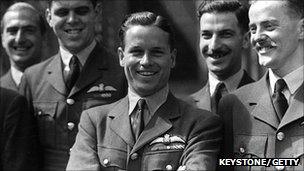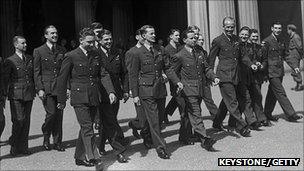'Friendly fire' claim over Dambuster Guy Gibson's death
- Published

Wing Cdr Gibson, centre, was 26 when he died
A film maker claims to have uncovered evidence that "friendly fire" was responsible for the death of Dambusters hero Guy Gibson.
Wing Cdr Gibson, who led the famous bouncing bomb raids on German dams during World War II, died in a mysterious plane crash in 1944.
A number of theories have been put forward, including a fuel gauge error.
Now producer James Cutler has said he has a tape in which a British airman admits to shooting him down.
Wing Cdr Gibson commanded 617 Squadron, a force of Lancaster bombers specially formed at RAF Scampton in Lincolnshire to attack dams in Germany's Ruhr Valley.
He was awarded the Victoria Cross for his part in the operation, which breached two of its targets in May 1943.
The 26-year-old was killed when his Mosquito plane crashed on its way back from another mission in Germany the following year.
No official reason was ever given for the fatal crash.
But Mr Cutler, who has been researching Wing Cdr Gibson for a new Dambusters film being made by Lord of the Rings director Sir Peter Jackson, claimed the taped account had solved the mystery.

Wing Cdr Gibson received his Victoria Cross at Buckingham Palace in June 1943
He said the cassette features Sgt Bernard McCormack, who was in Wing Cdr Gibson's formation of 227 Lancaster bombers and 10 Mosquitoes on the mission, admitting to bringing down Wing Cdr Gibson's Mosquito after mistaking it for an enemy craft.
Recorded by Sgt McCormack prior to his death in 1992, the tape describes how he was returning from Germany to RAF Woodall in Lincolnshire when he spotted what he thought was a German Junkers 88.
He said he loosed off 600 rounds of machine gun fire, bringing it down over the Dutch town of Steenbergen.
But at a debriefing by RAF intelligence it was revealed he had actually shot down Wing Cdr Gibson and his navigator Jim Warwick.
Mr Cutler was given the tape by Sgt McCormack's wife.
He said coordinates given in a classified combat report from Sgt McCormack's crew found in the National Archives backed up the pilot's account.
He said: "When I first heard the tape I thought 'It's just a story told by old comrades'.
"But then when we found the documents the hairs on the back on my neck stood up.
"I realised one of the great mysteries of World War II may have been answered."
However some experts in Lincolnshire said they still favoured the traditional explanation.
Roger Crisp, from RAF Scampton Historical Museum, said: "Gibson was very egotistical, he liked to be the best at everything and he was impatient.
"He did not do a proper conversion course on the Mosquito and when he went on his last mission his navigator had not flown a Mosquito before and one of the navigator's tasks was to change the fuel tank over."
An RAF spokesman said: "A long time has elapsed since Wing Commander Guy Gibson and his navigator went down.
"We simply don't have the facts available to corroborate this idea and it is therefore one of a number of theories about why the aircraft crashed."
- Published12 June 2011
- Published10 June 2011